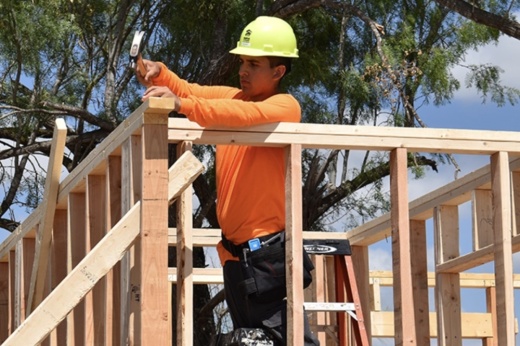Bexar County commissioners on Aug. 9 approved a process for spending $20 million to bolster organizations and agencies working to build new affordable housing and preserve existing homes and apartments as affordable residences.
Some of the $20 million for affordable housing will also be directed toward supportive housing for the homeless, county officials said.
Money for both of these initiatives come out of the total $389 million in American Rescue Plan Act funds received by Bexar County.
David Marquez, the county’s executive director of economic and community development, said because the affordable housing framework uses ARPA State Local Fiscal Recovery Funds, the county must abide by federal criteria to solicit and select affordable housing projects.
The county’s affordable housing program criteria include:
- agencies experienced in managing federal grant money;
- projects located in qualified census tracts;
- projects eligible for funding under the Home Investment Partnerships Program;
- projects ready to proceed to construction phase within six months of submission to the county;
- projects targeting vulnerable populations, such as children aging out of foster care, individuals unable to complete daily living activities, and veterans;
- projects leveraging local, state and federal funds, especially those awarded 4% or 9% state tax credit allocations; and
- projects that incorporate environmentally sustainable development practices.
Marquez said $8 million in ARPA money will be set aside for new construction and preservation of existing housing units for multifamily rentals for people earning between 16% and 60% of the area median income. The San Antonio-New Braunfels AMI is $83,500 for a four-member household, according to the U.S. Department of Housing and Urban Development.
Another $5 million will be directed toward new construction and preservation of single-family homes for people earning between 31% and 60% of the AMI, Marquez said.
Marquez said the remaining $7 million in ARPA money will be budgeted for supportive housing for people experiencing homelessness.
“I think this [investment] will [be] that sweet spot of affordability between 31% and 60% AMI,” Marquez said.
Precinct 4 Commissioner Tommy Calvert expressed concern about one criterion involving shovel-ready projects, saying such a requirement may accidentally result in county staff nixing some worthy housing proposals.
“The feedback I’ve gotten from the development community is that this could hurt the scoring on many projects that are very important and have good merit,” Calvert said.
Marquez said county staff will return to Commissioners Court with a list of recommended housing projects that will include select existing proposals and new ones that may come through a newer request for proposals.
County Community Development Director Robert Reyna said the fallout from the COVID-19 pandemic exacerbated conditions for many homeowners and renters who have financially struggled to pay their mortgage or rent and other housing-related expenses.
According to the San Antonio Board of Realtors, the average rental price in Bexar County is $1,850 per month. The U.S. Housing and Urban Development Department indicates nearly 1 in 5 Bexar County households is “cost burdened,” meaning those households spend a significant amount of income on monthly costs of living.
“The imbalance between rental supply and demand decreases affordability and precipitates housing instability, particularly among low- and moderate-income households,” Reyna said.
Regarding homeownership, according to the U.S. Census Bureau, the owner-occupied housing unit rate in Bexar County is 58.5%—below the state average of 62.3% and the national average of 64.4%.
Additionally, San Antonio Board of Realtors data indicates the median sales price of a local single-family home rose 20% over the past year to $348,200.
“The rapid increase in home prices in Bexar County has placed single-family homes beyond the reach of low- and moderate-income households,” Reyna said.
Regarding homelessness, according to the South Alamo Regional Alliance for the Homeless, the 2022 point-in-time count found 2,995 people in Bexar County experiencing homelessness, a 2% increase from 2020.
Reyna said many people coping with chronic housing instability frequently find themselves arrested and temporarily jailed for a variety of misdemeanors. He added that nationally, about 50% of homeless individuals have co-occurring substance abuse disorders and that 71% of local homeless individuals have reported mental health issues.
“People with mental health and substance abuse disorders often require supportive housing following discharge from inpatient treatment to reduce risk of homelessness,” Reyna said.
Officials of local nonprofits that specialize in developing affordable housing praised Bexar County for establishing a spending framework to help increase affordable housing.
SAMMinistries President/CEO Nikisha Baker said 20% of Bexar County residents live at or below the federal poverty level, and another 30% are classified as the working poor. According to the U.S. Department of Health and Human Services, the federal poverty guideline for a three-member household is $23,030.
“That leaves about 500,000 Bexar County households one paycheck away from homelessness,” Baker said. She voiced appreciation for county leaders’ action Aug. 9.
“Your investment in safety net services and homeless services helps to ensure men and women are gainfully employed, that children are able to remain in school, and those who need longer-term support receive the services that they need to overcome homelessness and become self-sufficient,” Baker said.
Debra Guerrero, an executive with development firm NRP Group, thanked commissioners for emphasizing the importance of public-private partnerships to support growth of affordable housing.
Guerrero said certain developments that her company oversees have slowed down because of rising construction costs and interest rates, which in turn creates gaps in the overall housing market, particularly for people seeking affordable housing options.
“For you to take ARPA funds and apply them to these gaps—these types of financed deals—is very important,” Guerrero said.
NRP Group has built more than 12,000 affordable housing units across Bexar County in the past 18 years, Guerrero added.
“We need partnerships like this to continue to house our families,” Guerrero said.
Michael Taylor, executive vice president and chief operating officer for Habitat for Humanity of San Antonio, said financial assistance such as the ARPA funds permit organizations such as HHSA to build infrastructure to support affordable home ownership.
“It also allows us to leverage millions more in funds that we receive from individuals, businesses, churches and other organizations that support the work that we do,” Taylor said.





